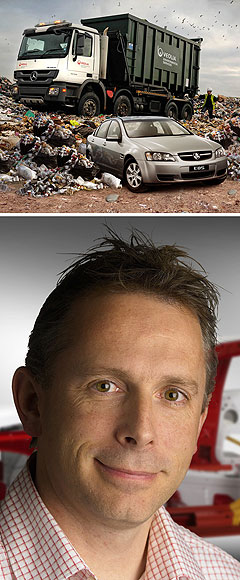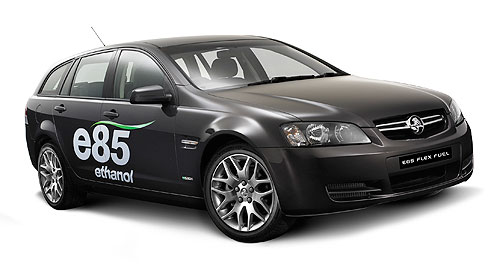News - Holden - CommodoreCaltex gets set to pump up E85Carbon cutter: Holden's new E85-capable Commodore will have fuel to burn, thanks to Caltex's Bio E-Flex roll out. New Commodore launch to coincide with ethanol rollout by October2 Aug 2010 OIL company Caltex Australia has started rolling out its Bio E-Flex-branded E85 ethanol-petrol fuel pumps across Australia to coincide with the national launch of Holden’s E85-capable VE Series II Commodore around October. The oil company has promised 31 E85 outlets in Melbourne, Sydney, Brisbane, Adelaide and Canberra by October 1, with expansion to 100 metropolitan and regional locations by mid 2011. Caltex today joined with Holden and the Victorian government to show off the new pumps at a service station at Footscray, in Melbourne’s west, although those particular pumps will remain dry for a couple of weeks. Caltex was tight-lipped on the projected price of its E85 fuel, except to say it would be competitive with petrol and that the price differential with petrol would be consistent across its network. Two existing E85 outlets in Melbourne are already selling the fuel for $1 a litre – about 30 per cent cheaper than the standard 91 RON unleaded price. E85 fuel theoretically is a blend of 85 per cent ethanol and 15 per cent petrol, although the ethanol content of the brew supplied by the refinery can be cut to as little as 70 per cent in winter to help fire the engine in cold starts. Cars running on E85 are said to use 10 to 15 per cent more fuel, but with a higher octane rating, they produce more power. Cars have to be filled more often, but with a 30 per cent price discount over petrol, motorists should come out ahead.  Left: One day, rubbish is expected to supply ethanol for Holden's new Commodore. Below: Holden energy and environment director Richard Marshall. Left: One day, rubbish is expected to supply ethanol for Holden's new Commodore. Below: Holden energy and environment director Richard Marshall.Caltex estimates a 50 per cent greenhouse gas saving from E85 over petrol, due to the renewable nature of the source material which so far in Australia includes sugar cane, sorghum and wheat gluten starch waste. However, it concedes that figure can vary considerably, depending on the percentage of ethanol in the mix, CO2 production in the source material and many other factors. Initially, Caltex will source the ethanol for its E-Flex fuel from three existing ethanol plants in Queensland and New South Wales. Longer term, Caltex is hoping to source ethanol from American-based bio fuels producer Coskata which, in partnership with Caltex, Holden, Veolia and other companies, is looking to establish a plant in Victoria to generate 200 million litres of fuel a year from waste. That plant – announced in March – is contingent on state government financial support, and GoAuto understands the plant is still not locked in, with talks between the partners continuing. No opening target date has been set. Holden’s Series II Commodore will become the first locally produced car capable of running on E85, but not all models will be equipped with necessary ‘flex fuel’ modifications that include changes to the fuel delivery system and engine management software. Holden’s energy and environment director Richard Marshall said E85 capability would be extended to other models as part of Holden’s EcoLine strategy that also includes the dual-fuel LPG Commodore and, ultimately, the plug-in Volt petrol-electric hybrid. He said the roll out of flex-fuel Holden models and Caltex’s E-Flex fuel outlets went hand in hand. “For Holden to bring flex-fuel vehicles to market, it is imperative that customers can buy the fuel from a network of pumps that are easily accessed,” he said. “The commitment made by Caltex to install 100 pumps by mid 2011 will help make this a reality.” Mr Marshall said Holden had not been deterred by the federal government’s plan to charge an excise on ethanol, which is currently exempt from fuel taxes that slug petrol 38.143 cents a litre. He said Holden had welcomed the announcement of the excise, which he said had provided clarity for the future of ethanol. “The excise starts at 2.5 cents a litre and increases incrementally to 12.5 cents a litre in 2015,” he said. “If petrol is not 12.5 cents a litre dearer by 2015, then I would be very surprised.” Caltex Australia manager of government affairs and media Frank Topham said that in many Caltex service stations, the white-coloured E-Flex nozzle would line up alongside standard unleaded, Vortex 95 and Vortex 98 outlets. He said that in New South Wales, standard unleaded fuel would be replaced by an E10 (10 per cent ethanol-petrol blend) by law by the middle of next year. So far, 400 Caltex service stations were already carrying E10. The E-Flex nozzles carry red tags warning motorists that the fuel should only be used in E85-capable cars. According to Holden, filling a conventional petrol car could cause it to not only run rough but could potentially damage the fuel pump. The damage would not be as severe as filling a petrol car with diesel, which can cause engines to blow up, but the tank would still have to be drained of E85 and refuelled with petrol. E85-capable cars, on the other hand, can run happily on normal petrol, thanks to sensors that adjust the engine's electronic controls. Apart from the forthcoming Commodore, some late-model Saab, Chrysler, Dodge and Jeep models are already E85 capable, while several other manufacturers such as Volvo have such models waiting in the wings. Australia’s premier motor racing category, V8 Supercars, already runs on E85 supplied by Queensland-based sugar producer CSR.  Read more23rd of March 2010  Holden steps up ethanol-from-trash pushVictorian ethanol plant and expanded E85 network to power new flex-fuel Holdens8th of September 2009  E85: Commodore’s next big thingEthanol cars to replace up to 30% of petrol Commodore sales from late next year |
Click to shareHolden articlesCommodore pricing
Motor industry news |
















Facebook Twitter Instagram